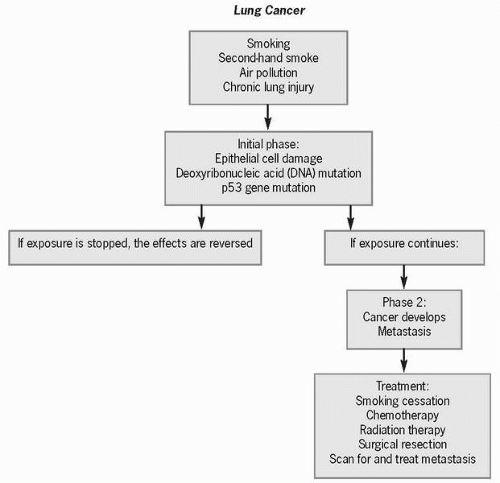Lung Cancer
Lung cancer is a neoplasm that arises out of lung tissue. In addition to primary tumors occuring in the lungs, cancer arising from other sites, such as the breast, frequently metastasize to lung tissue. It is currently the leading cause of cancer deaths among both men (32%) and women (25%), with more African Americans than whites developing the disease. Mortality rates for lung cancer approach 90%, with a 5-year survival rate after diagnosis approaching only 15%.
Each year approximately 180,000 new cases of lung cancer are diagnosed, and the vast majority of these cases (80-90%) are directly linked to smoking. Cigarette smoke contains 4,000 chemicals, 43 of which are known carcinogens, including tar, which paralyzes cilia. Other causes of lung cancer include second-hand smoke inhalation, which causes
between 500 and 5,000 deaths per year; inhaled carcinogens such as asbestos; and chronic lung disease such as chronic obstructive pulmonary disease in which mucociliary action is diminished, resulting in poor removal of airborne carcinogens.
between 500 and 5,000 deaths per year; inhaled carcinogens such as asbestos; and chronic lung disease such as chronic obstructive pulmonary disease in which mucociliary action is diminished, resulting in poor removal of airborne carcinogens.
There is a direct correlation between the age a person began smoking, how much and how long he or she smoked, and the likelihood of developing lung cancer. People who began smoking in their teenage years, inhale deeply, and smoke at least one-half pack per day have the highest risk of developing the disease. Someone who stops smoking experiences a gradual decline in lung cancer risk. Recently, attention has focused on the risk of developing lung cancer for those exposed to second-hand smoke, such as someone living with a smoker and restaurant/bar workers. Research has indicated that second-hand smoke may contain more carcinogens than inhaled smoke. It takes between 10 and 30 years after exposure to the carcinogens in cigarettes for lung cancers to develop. This accounts for the incidence of lung cancers in people who develop the disease years after they stop smoking. Smokers who are also exposed to other environmental carcinogens, such as air pollution, are at a very high risk for developing lung cancer.
Bronchogenic cancers arise from epithelial cells of the respiratory tract and are aggressive. The first phase of lung cancer development involves irreversible cell deoxyribonucleic acid (DNA) mutation of oncogenes and tumor suppressor genes because of exposure to carcinogenic substances. The p53 gene, a tumor suppressor gene responsible for controlling cell replication, is one of those genes
mutated. Over time, exposure to carcinogenic environmental agents alters the growth and reproduction of the affected cells. If exposure to the carcinogens is stopped, the effects are reversible. If the exposure to carcinogens continues, cancer develops.
mutated. Over time, exposure to carcinogenic environmental agents alters the growth and reproduction of the affected cells. If exposure to the carcinogens is stopped, the effects are reversible. If the exposure to carcinogens continues, cancer develops.
 If exposure to the carcinogens is stopped, the effects are reversible. If the exposure to carcinogens continues, cancer develops.
If exposure to the carcinogens is stopped, the effects are reversible. If the exposure to carcinogens continues, cancer develops.Stay updated, free articles. Join our Telegram channel

Full access? Get Clinical Tree


Get Clinical Tree app for offline access





